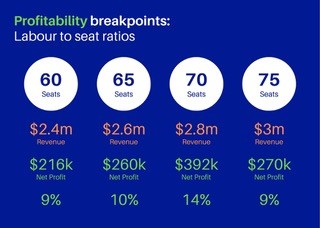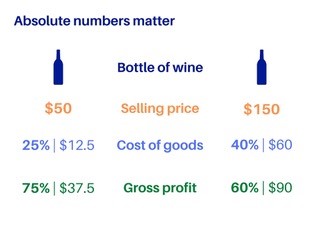The New Zealand hospitality industry has seen significant change over the last three decades. It’s grown up and is now an integral and essential part of our everyday life.
it.

The overall profitability of our sector, has declined. To thrive and survive our focus needs to be on Net Profit. Without profit we can’t re-invest in our staff, ourselves, or our businesses. We seem reluctant to talk about “how” to make our businesses profitable, as if it’s a secret not to be shared. I am here to discuss a variety of ways of looking at our net profit.
The hospitality industry attracts creative, vibrant, talented, fearless people.
They can cook, are great at serving customers, understand market trends, and how to create a slick ambiance. However there is often little knowledge of the fundamentals of business.
We don’t have a culture of sharing financial information or ways of presenting this information in an easy, understandable, and manipulatable way. Often putting off financial analysis, as something to be done when it has to, or at the end of the financial year, or when we struggle to pay bills.

Imagine, if some of that same drive and energy that is behind our unique venues was directed into analysing what the potential “Net Profit” for those same venues might be able to generate, by easily understanding the levers that exist within our businesses.We need to focus our attention on this, and discuss how we can look at it differently.
My belief is that if we look at Net profit from different angles, then the greater our understanding can be. On that note here are some examples of exactly that…
We need to consider that unlike a lot of other industries that sell a product or service, we do both: we manufacture and retail our products.
So relying on just “costing our products” can give a slightly false sense of what we are actually making in terms of gross profit. Manufacturing some of our products can be very simple, efficient and profitable while others are not. Determining which is which becomes time consuming, complicated, but very important. Once we factor in all the other costs associated with producing an item, whether it is a Flat White or a Ribeye Steak, we start to see that every unit has different costs and therefore a different profit.
We start to understand where our sweet spots are and which are our pain points. As we do this we see clearly which products we should promote and which we may need to minimise or stop altogether.
Our industry is dynamic, our customer flow is not always in our control. Therefore the impact of time, days of the week, seasonality, are often factors we don’t see or can adjust to easily. We don’t make the same profit from our Flat White or our Ribeye everyday, or every week, or even every season. Yet we price our goods as though we do, since we often price them solely from a cost of goods perspective. If we just look at things from a cost of goods perspective – we can get blindsided again. We need to take this into account when pricing, and understand that even though they may be properly costed, we will still lose money on these dishes at times. To counter this many other industries price dynamically, adjusting their prices to suit demand. While it is more difficult for us to do this it shouldn’t stop us from thinking about different ways to do exactly that.
The term “Fixed Costs” implies that these very costs are fixed. They are Fixed insofar as that’s what you pay in Rent every month. They are not fixed in relation to your revenue.
Therein lies the misconception, because when we consider them as fixed costs we don’t appreciate that we have the ability to manipulate them.
Getting our fixed costs to diminish is where the hidden profit can lie, by reaching a tipping point where those very costs are covered/absorbed, therefore we are better able to make a profit. In the early part of my career I wish someone had explained this concept properly to me. A lease with percentage of revenue clause is solely for the benefit of the landlord.
Revenue is important, but understanding how it’s important is essential. By increasing revenue from $2M to $3M, rent as a percentage of our turnover dropped from 7.5% to 5%.That reduction of 2.5%, small as it seems, was incredibly significant. As that reduction in an industry which struggles to make an average of 10% Net Profit, equated to an increase of 25% in our profitability.

Labour is and will be our most significant expense in the short to medium term.
It’s useful to think of labour as a staircase line in relation to revenue.
As our Revenue increases, so too does the cost of Labour associated with that increase.
It is rarely a straight line increase consistent with the revenue increase, generally the cost of Labour is always slightly out of whack with your revenue. The same is true in reverse. It works more like a staircase than a line.
The key points are not to get stressed when trying to grow your revenue. When starting out with a new venture. Labour costs will be an unnecessary distraction.
The critical point, is where you are aiming for on the staircase. Ideally it is just before the next riser, when you are neither over or under staffed. That point where your revenue and your labour costs are best aligned.
There are number of ways to align these costs. One way is to get to consider whether you’ve got the right number of seats in your venue. Often we find a space to lease, either existing or perhaps a bare shell and then we set about filling it with seats. After all seats means customers and customers means revenue. Stop and consider whether this number of seats is the optimum for your particular venue. For some venues removing 10 seats may make them more profitable for others quite the reverse.
Why is this ? It is about understanding a number of things. What is the minimum number of staff you need to operate on any shift. From there you can determine whether you are actually better off turning away business on some occasions rather than just accepting it. Not building your business model for the exceptions, but for the everyday, which is where it is most likely to operate.
What is the sweet spot of seats in your establishment ? To reiterate more seats may mean more revenue, but is that Profitable revenue ?The diagram above shows us that finding that sweet spot can mean removing seats. There is a saying…”You can’t bank percentages, you can only bank dollars” In simple terms the higher the selling price the less the cost of goods impacts on our margin. To demonstrate this point let’s look at 2 different bottles of wine on a wine list. Bottle “A” sells for $50, with a cost of goods at 25% and Bottle “B “sells for $150, with a cost of goods at 40%. We also know that as listings become more expensive there can be a reluctance to purchase by the customer, so we are also trying to incentivise the customer to spend up by providing value.

We can’t always apply the same margin as products increase in cost.
At first glance Bottle “A” seems like it’s the smart play, after all it has a significantly lower cost of goods, whereas Bottle “B” carries a much higher cost of goods.
When looked at purely from a lower cost of goods percentage (which we often do because we are trying to keep our cost of goods down) you assume that Bottle “A” is better. However in reality as the absolute numbers increase the products ability to contribute to other cost increases. Bottle “B” generates significantly more dollars, it returns $90, whereas the other returns $37.50. This means that the more expensive bottle is actually able to make a much greater contribution to all our other costs. Which in turn effectively lowers the other costs associated with that product. The diagram below helps demonstrate this point.
Again only looking at how we generate Profit in our businesses from a cost of goods perspective means that we can get stuck in that mode. While that view is useful most of the time it’s also important to realise it has limitations, as absolute numbers matter absolutely.
I’m currently developing a tool, ProfitShape to help business owners like you, look forward and model out the financial implication of the decisions you wish to make. To project forward some real life “what if scenarios” and see how they impact on your business.
If you would like more information on ProfitShape please visit us at profitshape.com or alternatively you’re welcome to message me directly at james@profitshape.co.nz
